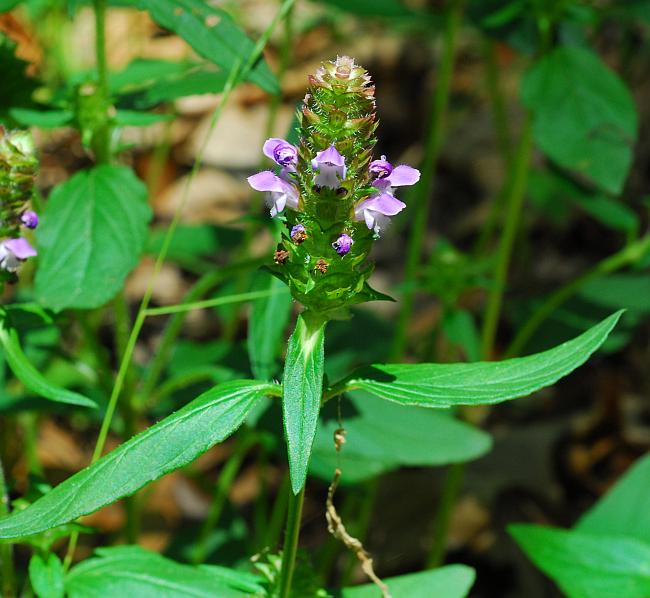Prunella vulgaris L.
Self-Heal

Native
CC = Amb
CW = 3
MOC = 85
© SRTurner
Prunella vulgaris L.Self-Heal | |
 |
Native CC = Amb CW = 3 MOC = 85 |
© SRTurner |
|
Family - Lamiaceae Habit - Perennial forb, fibrous-rooted, occasionally with short rhizomes. Stems - Erect (or rarely creeping), to 50 cm, bluntly 4-angled, sometimes branched, single or multiple from base, glabrous or sparsely to moderately pubescent with short, ascending hairs or spreading to somewhat curved, multicellular hairs, these sometimes only toward the stem tip or mostly along the angles and at the nodes.
Leaves - Opposite, simple, petiolate. Petioles long at base of plant, reduced above, villous, winged on upper leaves. Blades 2-9 cm long, 0.7-4.0 cm wide, lanceolate to oblong-ovate, rounded, angled, or tapered at the base, angled or tapered to a bluntly or sharply pointed tip, the margins entire, shallowly wavy, or finely and sometimes irregularly toothed, the surfaces glabrous or sparsely short-hairy, the undersurface usually also with inconspicuous, sessile glands.
Inflorescences - Terminal, dense spikes, more or less continuous, with usually 6 flowers per node, each node with a pair of leaflike bracts, these 5-15 mm long, 7-14 mm wide, depressed-ovate, abruptly short-tapered to a sharply pointed tip, the outer surface usually strongly purplish tinged, the margins usually densely hairy. Bractlets absent or minute, linear. Flowers sessile.
Flowers - Calyces zygomorphic, 6-10 mm long at flowering, 2-lipped, more or less cylindric to narrowly bell-shaped, the tube irregularly 10-nerved, hairy, glabrous in the mouth, the lips longer than the tube, the upper lip relatively broad and with 3, shallow, equal, triangular lobes at the tip, the lower lip narrower and deeply 2-lobed, the lobes narrowly triangular, the lobes all sharply pointed, hairy along the margins, not or becoming only slightly enlarged and somewhat leathery at fruiting. Corollas zygomorphic, bilabiate, 10-15 mm long, the lower lip with darker nerves or central spot, the outer surface glabrous or sparsely hairy, the tube funnelform, 2-lipped, the lips shorter than the tube, the upper lip entire or occasionally minutely notched, hooded, purplish blue to purple, often pale along the margin, the lower lip shorter than the upper lip, shallowly 3-lobed, spreading, white to pale lavender, usually with a darker line or markings on the inner surface, often somewhat irregular to shallowly fringed along the margins. Stamens 4, curved under the upper lip, the filaments more or less forked near the tip, only the lower forks bearing the anthers, the anthers small, the connective somewhat expanded, the pollen sacs 2, spreading, dark purple to bluish purple. Ovary deeply lobed, the style appearing nearly basal from a deep apical notch. Style not or only slightly exserted, with 2 slender branches at the tip.
Fruits - Dry schizocarps, separating into usually 4 nutlets, these 1.6-2.0 mm long, ovoid to ellipsoid, the surface yellowish brown to brown with darker longitudinal lines that tend to converge at the ends, glabrous, smooth, shiny, the basal end with a small, pyramidal, white caruncle. Flowering - May - September. Habitat - Forests, streambanks, pond margins, upland prairies, tops of bluffs, pastures, fencerows, fields, ditches, railroads, roadsides, and disturbed areas. Origin - Native to Europe, Asia, and North America. Lookalikes - None. Other info. - This species is common across most of Missouri, less so in a few northwestern counties. It is found to at least some extent in every state in the U.S., including Alaska and Hawaii, and much of Canada. The plant's inflorescences are distinctive and unique among Missouri's flora. They are often observed with only a few flowers open, at irregular points around the inflorescence. The plant is generally quite small, blooming at just a few cm in height if it is growing in an area which is frequently mowed. The species designation vulgaris means "common" and is frequently used in botanical nomenclature to describe plants that are indeed common. The term "self heal" refers to the extensive and varied uses of the plant in traditional medicine. The plant is also edible and can be used in salads or as a cooked vegetable. Photographs taken off Hwy V, Shannon County, MO., 5-23-03 (DETenglia); also at Shaw Nature Reserve, Franklin County, MO, 6-30-2007, and Pea Ridge Conservation Area, Washington County, MO, 6-8-2013 (SRTurner). |